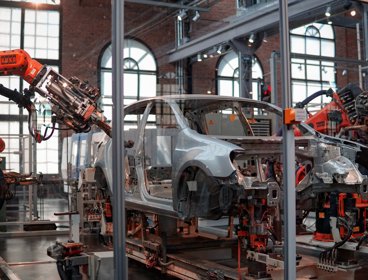His work focuses on a variety of areas including frugal innovation in India, how 3D printing may help manage development issues as well as how manufacturing practices change over space, place and time. His research paper on The Making of Geographies of Manufacturing won the 2013 Area journal prize. We spoke to Thomas about this paper and the research that surrounded it.
What was the ‘Fill the Ships’ campaign in post Second World War Britain?
Much like ‘Make Do and Mend’ and ‘Keep Calm and Carry On’ the ‘Fill the Ships and We Shall Fill the Shops’ campaign sought to encourage and renew certain types of (what we would now see as ‘high carbon’) behaviours and habits in the British and indeed the Commonwealth. After the Second World War there was a great sense of relief and a collective yearning for luxury, comfort, convenience and leisure. Unfortunately, the UK was in no shape economically to let its citizenry take a break from the hard times they had gotten used to during the war. So the government had to convince the UK public to fight a new war on the Home Front against indolence, workshyness and debt.
Can you ever see a time when the UK might return to simplified, bilateral trade as was mostly the case prior to the Second World War?
There are many possible futures and certainly one that springs to mind that fits this bill is in the UK Government Foresight ‘Living in the City’ report (Urry et al, 2014) which I co-authored. One of the worlds, the ‘Liveable City’, is defined by a dramatic ‘powering down’ of society. Local innovation and wellbeing take precedence in this UK future over high-carbon living and global trade. While by normal economic measures people are ‘poor’, there is far less hidden wealth stemming from tax havens, offshoring and global asset ownership. Trade between regions is judged profitable by how much it benefits communities rather than how much it encourages economic growth and, being more transparent and open, it is also possibly simpler and even bilateral too. Unfortunately, the less positive ‘Fortress City’ world in this report could also fit the bill in its imagining of a return to geopolitical regionalism, conflict over resources, and imperial hegemony.
The ‘Fill the Ships’ campaign was borne of a time before Trans-National Companies (TNCs) really dominated the global trade picture – how might their further inclusion change your picture of future manufacturing ideologies?
TNCs float above countries and their governments and define the standards of labour in developing regions. Currently ‘business-as-usual’ in global trade is to further delink TNCs from nation-states and geopolitics except in cases of massive profit-making due to conflict (for example in the resource-rich Middle East). In contrast, there was a maternal/paternal sense of care remaining in Post-War Britain for its ex-colonies, which is perceivable in the ‘Fill the Ships’ campaign. For the many manufacturing regions that were only recently a part of the British Empire (India being the largest and having achieved independence in 1947) this slowly diminished in the second half of the twentieth century as the US became a centre of power. Future manufacturing ideologies will need to account for the hegemony and politics of TNCs that have little to no sense of geographical responsibility arising from a shared provenance.
You quote the need for a ‘New Home Front’ to emerge in the UK and in other developed countries – what do you mean by that?
In the context of some governmental and intergovernmental efforts to encourage less consumption, less transportation, less energy-use in response to climate change, there has been much debate about the nature of low-carbon living in the twenty-first century. Some commentators have looked back to the Second World War as a model for achieving more sustainable practices; this is the ‘New Home Front’ idea - yet, what goes unacknowledged is how luxury commodities in the war effort made austerity palatable. It was the debt accumulated to keep flows of these commodities going during the war that panicked the post-war government into the ‘Fill the Ships’ campaign. So the question is: ‘can we have our cake and eat it too’ when we consider a New Home Front and an absence of the luxury we are used to in the developed world? Can we perhaps learn to ‘make do and mend’ again from the developing world by copying, for instance, Indian practices of making do such as ‘jugaad’ – the idea of fixing a complicated situation with simple technology?
If we want manufacturing to return to developed nations, then Britons would have to rethink their ethical standpoint towards trade – so how might a modern ‘Fill the Ships’ campaign look?
One possible area where the return (or on-shoring) of manufacturing to the developed world is being considered is in digital fabrication technologies (e.g. 3D printing). If people can ‘print’ out the objects they need and want then the vast system of production and consumption might be circumvented or reduced. The jury is still out on whether this is just fantasy. Certainly government initiatives such as the ‘America Makes’ campaign (https://americamakes.us/ ) are a step in the direction of encouraging consumers to be less passive and more involved in the production process. And if they are more involved they might be more efficient, ethical and careful, or so the reasoning goes.
Do you think any such campaign would be successful or are we too well informed today of competing alternatives?
The rise of TNCs accompanied the emergence of branding, advertising, marketing and what social commentator Raymond Williams termed the ‘magic system’ (Williams, 1980). The reason that this system is magical is because it appears to happen ‘like magic’ in that consumers do not see the huge factories, sometimes unethical working practices, environmental consequences and excessive profits (for a few) of the global system of production that happens offshore from the developed world. In essence the ‘Fill the Ships’ campaign was a nascent form of marketing and within this propaganda are many of the techniques TNCs use now to influence people’s habits and behaviours such as ‘Just Do It’ (Nike). It is now unlikely that governments will be able to play TNCs at their own game in order to ‘spin’ austerity. A campaign that could achieve fair trade and low-carbon living as well as the return of manufacturing to the global North is unlikely simply because TNCs are exemplary at propaganda and they have no vested interest in onshoring manufacturing as they are not regionally affiliated very much.
Could the most recent economic crisis have been lessened had the UK had a stronger manufacturing base?
In the ‘Fill the Ships’ campaign there was a sense of alarm that Britain had been living ‘above its means’ during the war despite the extensive austerity and rationing that had gone on in the Home Front. Fear of national and personal debt drove the urgency of this campaign and this is in marked contrast to the awareness of debt in the recent global financial crisis, either at a personal or national level, in the UK. The issue in regards to manufacturing is that countries such as China, which are industrialising, are in essence the debt-collectors in global financial crises. So there is certainly a relationship between manufacturing and national debt that begs further analysis.
After the Second World War, the ‘Fill the Ships’ campaign was motivated by the spread of US consumer culture which made Britons want new, luxury goods as easily as their North Atlantic allies. What trends in the US herald the return of production to the UK today?
In hindsight, we can see that the low-carbon lives people had created during the Second World War on the Home Front in fact depended on the accrual of debts overseas (largely in the US) so that the meagre number of luxury products that had fortified the British through the War, and which were impossible to produce locally in a state of austerity, could nevertheless be maintained such as petrol, cotton, tobacco and cocoa. US culture continues to play a huge role in consumption ideologies; however, interestingly there are similar austerity movements in the US that emerged in response to the Vietnam War (e.g. ‘hippy’ culture) that do not support ‘unfair trade’ and offshoring and instead champion local maker cultures and more ethical consumption.
Your paper creates good grounding for us to research management solutions to current geographical challenges from the history books. To which other areas of geographical thinking might this apply?
Interestingly, the paper also offers lessons for those interested in environmental geography in light of the Anthropocene: the recent epochal period that is visible in the geological record because of the affect humans are having on the climate through their emissions of fossil fuels. The call for the urgent decarbonisation of societies in response to climate change, in lieu of radical geo-engineering projects or magic bullet technology solutions, has parallels in the social change experienced during the Home Front in the Second World War. This raises several questions in itself: How can governments market austerity to citizens? How can campaigns calling for resources to be left in the ground (such as 350.org) compete against campaigns that entreat people to continue to fill the ships to fill the shops?
References
-
Urry, J. Birtchnell, T. Caletrio, J. and Pollastri, S. (2014) Living the the City:Future of Cities Working Paper, Foresight: Government Office for Science, London
-
America Makes (the National Additive Manufacturing Innovation Institute)
-
Williams, R. (1980) Advertising: The Magic System in Problems in Materialism and Culture, London, Verso pp170-195


